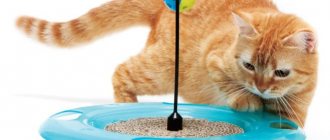How to get rid of dog hair in an apartment? If you have a dog or cat, you know one thing - their hair is everywhere. And if you have several animals, we express our deepest condolences to you.
Trying to keep your home clean and free of dog hair is something we all deal with. Luckily, there are a few tricks that make the process a little easier. Here are 10 tips for cleaning your apartment from fur.
You can purchase a special vacuum device designed for pets or a wet vacuum cleaner. When it comes to cleaning wool, it's important to stick to the basics. Plenty of household items are great for collecting all that pesky fur.
We offer 10 tips for getting rid of hair. This is a list of proven dog hair removal tools, from high-end devices to simple household ones.
Why does a cat have a lot of hair?
Shedding in cats is a seasonal phenomenon. Both house and yard mooses shed their fur in spring and autumn, but the first moults also shed in winter - during the heating season. The undercoat of cats also falls out significantly after childbirth due to hormonal changes in the body. This is normal, you will just have to wait out this period.
However, if your cat's hair is growing so bad that bald spots appear on his thick hair, you should immediately consult a veterinarian. This may indicate a vitamin deficiency or a serious illness.
Alternative vacuum equipment
Essentially, these are devices designed for combing pet hair. This machine is convenient because it collects shedding hairs not only from the top layer, but also from the undercoat. Pets like this procedure because it imitates the natural stroking of an animal by a person. The principle of operation of a vacuum device is similar to a vacuum cleaner - the wool is sucked inside and collected in a container, which is convenient and time-saving. The device operates almost silently, so cats and dogs are not alarmed.
My cat has a lot of hair coming out, what should I do?
Owners often wonder: what to do to prevent a cat from shedding? To minimize the scale of the disaster, make it a habit to stroke the fur once a day with a special mitten. Brush long-haired cats with brushes. In the summer, the animal can be taken to a groomer, who will give it an interesting haircut, for example, a la lion.
Interesting.
Cats use their own method of getting rid of excess fur - licking. Veterinarians recommend giving your pet a special paste to remove hair from the stomach, or offering to chew green grass.
How to brush cats' fur? It all depends on the breed. There is a misconception that it is better to comb Persians with slicker brushes. In fact, this tool is not suitable, since it severely injures the soft, literally airy fur of the cat. Pay attention to combs or brushes made of quality materials. Short-haired cats can be combed with a rubber mitten, British and Scottish cats can be combed with a furminator, which does an excellent job in the undercoat. Comb the Maine Coon's luxurious coat with combs.
Take care of the proper nutrition of the animals - feed them exclusively high-quality dry or wet food, and best of all, holistic food. Consider switching to the BARF feeding system, which is based on feeding animals fresh meat, vegetables and fruits. This will maintain the balance of vitamins and minerals and keep your pet healthy.
Wall-mounted corner cat brushes are another way to reduce the amount of lint in your apartment. They are fixed on the protruding corners and treated with catnip. The cat will appreciate such a device and will be happy to rub its whole body against it. Murka - pleasure, less hassle for you!
Most cats do not like to bathe, but once every six months you can organize a bath day and wash the animal with shampoo. Choose a detergent based on your coat type and length. Complete the procedure with conditioner, which will help reduce static and smooth hairs.
Preventive measures to help reduce shedding
There are several measures that can reduce hair loss. Remember that every hair you remove from your pet is less hair that needs to be removed.
One simple way to reduce shedding is to brush your dog every day. The procedure should not be very long. A few minutes of brushing will help get rid of a lot of loose fur.
Regular washing also helps reduce shedding. There is no magic shampoo that works better than others. Just the physical action of water removes a lot of hair. Feeding high quality food reduces excessive loss. And of course, remember about parasites in animals that can cause hair loss. Give your pet health and safe removal of worms with the help of a natural complex.
How to deal with cat hair in an apartment
What to do if a cat sheds and how to remove hair from the floor, furniture and clothes? We will share with you universal methods of dealing with fluff in the house.
How to remove wool from the floor
The main assistant of any cat owner is a vacuum cleaner. Ideally, of course, a robot vacuum cleaner that will do all the work on its own while you enjoy a cup of aromatic tea. A regular vacuum cleaner does just as well, but requires your participation.
Wet cleaning should ideally be done daily, but rubbing with a cloth or waving a mop is very labor-intensive, and a home cleaner equipped with a surface-washing function will help you with this. However, a wet cloth perfectly collects hairs that a vacuum cleaner couldn’t handle. There are also special mops on sale with a rubber coating in the form of a roller that attracts hairs.
How to get rid of wool on a carpet
A turbo brush is the best way to remove wool from carpets. It wraps hairs and makes cleaning much easier. You can also use a stiff brush, but few people like crawling on the carpet on all fours.
How to clean furniture
Use a vacuum cleaner to clean furniture. Brush from top to bottom, first vacuum the shelves, then the fronts of the cabinets, then work on the window sills and only then move on to the beds and sofas.
There is an old but proven method for removing cat hair from upholstery: wet a sheet, cover the chair or sofa and tap it firmly with a beater.
How to remove cat hair from clothes and textiles
How to get rid of wool on clothes? It sticks to all fabrics and glitters treacherously on the street, revealing you as the owner of the cat. Hairs are especially noticeable on dark things.
The easiest way to remove hairs is with a wet palm. Run your hand over the clothing from top to bottom, rolling the wool into balls.
Use sticky rollers to clean things, choose reusable solid gel rollers to save your family budget. They can be washed with water.
To reduce static, wash clothes with conditioner or treat them with an antistatic agent. Keep closets closed and clothes hidden in covers.
Prevention measures
Using preventive measures, you can prevent wool from sticking to items of clothing, carpet and upholstered furniture:
When static electricity accumulates on things, animal hair sticks to them more strongly.
You can get rid of this by using antistatic agents. These include fabric softeners, antistatic sprays, etc.- If there are animals in the house, it is best to store clothes out of their reach - behind closed cabinet doors, in linen or plastic bags.
- The main preventive measure is systematic comprehensive care for the pet, including combing. This is especially important for long-haired breeds.
- Humidifying the dry air in the apartment helps reduce the sticking of lint on objects.
- It is necessary to regularly clean the animal's favorite place - a rug or bed, as well as towels. This will prevent the fur that has accumulated there from being spread throughout the house.
- Timely grooming and trimming for breeds that need it is one of the factors that helps fight hair in the house.
How to use cat hair
Does cat fur have any uses? Of course, you don’t have to throw it away, but put it to use. The hair has a gorgeous shine and a silky structure. From wool you can make a blanket, mattress cover, blanket, sciatica belt, and use fluff for wet and dry felting.
The dry felting method is used to create three-dimensional products. The fibers are tightly connected and form felt. Wet felting is ideal for creating small toys or decorations.
In Switzerland, cat hair has long been used to treat osteochondrosis. Their fluff is used to make belts and socks to increase blood circulation and relieve joint pain.
Some craftsmen make expensive jewelry and designer bags from wool.
Store-bought insecticides
Modern professional products used by insect control specialists no longer smell so unpleasant and are practically safe for humans and animals. Therefore, you don’t have to leave your apartment for several days if you need to get rid of fleas at home.
But not all chemicals sold on the market fit this description. Therefore, you must carefully read the instructions and be sure to follow safety precautions, protecting your nose, eyes and skin from getting poison.
The following will be effective against fleas:
- “Dichlorvos” and its many varieties;
- "Raptor";
- Raid;
- "Medilis";
- “Karbofos”;
- "Biorin";
- “Butox 50”;
- “Cucaracha”;
- "Biorin";
- "Tetrix";
- “Sinuzan”;
- “Cifox”;
- “Clean House” and others.
Before using chemicals yourself, you need to carry out a general wet cleaning and wash all things.
Then all household members go for a walk, and all surfaces, carpets and textiles are carefully processed. After 3-5 hours you can ventilate the apartment and return home. Over the next week, it is recommended not to wash floors, walls and furniture, but only sweep dead fleas into the trash bin.
Tips and tricks for pet owners
We have collected tips for caring for cats that will make your life easier:
- Provide your pet with a place to sleep, eat, and go to the toilet. Buy bowls for water and food, as well as a mat for them, as some cats eat sloppily, spilling water and scattering food on the floor. Place the house and scratching post in the corner of the room.
- Bathe your cat once every 3-6 months if she does not go outside for walks. If your pet is free-range, you will have to bathe it more often, because dust, dirt, and dry grass stick to its coat. The optimal water temperature is 38-38.5°C. Long-haired cats can be blow-dried on low setting.
- Brush short-haired cats once a week, or several times during the shedding period. Brush long-haired cats daily and trim mats if necessary. Remember, the softer the fur, the softer the brush, and vice versa.
- Trim the nails once every 2 weeks with a nail clipper, being careful not to catch a blood vessel.
- Clean your eyes and nose daily with a damp cloth or swab. If purulent discharge appears, contact your veterinarian.
- Clean your ears with a special lotion once a week. Earwax should be light in color and without an unpleasant odor; if it is darkened and smells bad, take your pet to the veterinary clinic.
- If there is no solid food in the diet, the cat needs to brush its teeth from plaque and tartar once a week with toothpaste for cats.
- Once every three months, it is necessary to show the animal to a veterinarian and promptly vaccinate. A specialist will examine your pet and be able to identify serious diseases in time. 10 days before vaccination, treat for worms.
Your favorite is a Chihuahua
Chihuahua is one of the most beloved dog breeds. There are smooth-haired breeds, and there are fluffy, cute creatures. But both of them shed. If shedding occurs frequently and very intensely, then take the dog to the veterinarian. The dog may be developing a disease. It could be:
- Hormonal disease.
- Allergy.
- Stress, eczema, fungus.
- Disturbances in the functioning of the endocrine glands.
- Parasites in the gastrointestinal tract. Every three months you need to get rid of worms. Once every 6 months, take a test for the presence of parasites, as well as a blood test.
How to ease the shedding period of a Chihuahua:
- Brush the coat daily with a special brush.
- Wash with shampoos from the anti-shed series. You can wash your dog only 2-3 times a year, and also when it is heavily soiled or in preparation for an exhibition.
- Feed with special food specifically for wool. Do not buy food by weight, it may be stale.
- Give dog vitamins A and B.
- Take your dog for walks in the fresh air more often, allowing him to run around more.
- Don't wrap it up too much. Overheating may cause the fur to fall out in clumps.
Ammonia
For the first method you will need ammonia.
First you need to prepare a solution of water and 10% ammonia. Dilute ammonia at the rate of 5 ml per 1 liter of water. If the item is bulky and dense, you can immediately take 10 liters of water and pour 50 ml of ammonia into it. If desired, you can add any essential oil to give things a pleasant smell.
Pour water into a basin (the water should be at room temperature), add ammonia and essential oil (optional).
Soak things in this solution for 2-9 hours depending on the density of the fabric:
- for cotton fabric 1 hour is enough,
- for synthetics and knitwear – 2-4 hours,
- for wool – 4-5 hours,
- for thick fabrics, jeans and outerwear, the soaking time increases to 7-9 hours.
When the required time has passed, wring out the clothes and hang them in a well-ventilated place for 24-48 hours, after which the clothes can be washed as usual.











